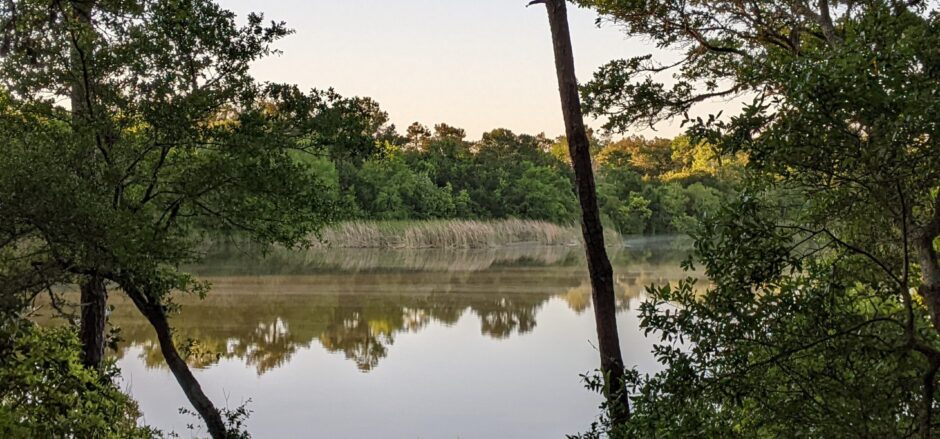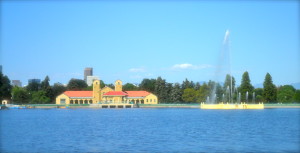On arrival in Denver, late 1967, I had the frequent changes of address common to the young. I lived in Capitol Hill on Race, then Lafayette, then York, always walking distance to Cheesman Park. Cheesman’s meadow is crowned by a neoclassical marble pavilion which had a glorious panorama of the Front Range. Mountains were new to me and the view thrilled me every time. I ran my fingers over the brass bas-relief mountain guide—Mt. Evans in the middle, Long’s Peak to the north—never grasping that those fourteeners were a hundred miles apart. My flatland childhood had been a place of narrow views.
I acquired a copy of Cheesman’s aboretum back then. The perimeter of the oblong park is planted with perhaps ten kinds of maple, nine of pine, eight oak, includes birch, catalpa, hawthorn, ash, honey locust, linden, aspen, elm, cottonwood, and more. The western walkway threading rows of those trees entered one of my poems.
Cheesman has a colorful history, was a cemetery from which, allegedly, all the bodies were never removed. It was a gay hangout when I walked it regularly and I felt safe there. I went to the park when I wanted to be alone, when I needed a whiff of nature. Roommates came and went, as did jobs and my brief first marriage. I sought solace for my failures in Cheesman, smoking and brooding.
I remarried, moved to the Northside, then to Virginia, raised stepchildren and didn’t visit Cheesman for a decade. When I did, my world had fractured again. I was startled to find that from the pavilion the canopy of trees reached past the foothills. They’d grown, formed a cathedral nave to walk beneath. The real shock was man’s doing. Standing where the view used to be, I mentally dynamited the high-rise condo that marred its middle, sent all my fury to will the collapse of those obscene walls.
In 1984, when the marriage that worked moved us to the Whittier neighborhood, City Park became mine for the long haul. Established in 1880, it’s one of Denver’s oldest. I’d been there as many have, with children, to visit the museum or zoo, rent paddleboats, or attend summer jazz concerts. In 1968, I went to a Be-In featuring Timothy Leary and west coast psychedelic bands there. We were a throng of hippie kids on best behavior: many gave gifts randomly to the crowd from baskets brought for the purpose—I got a handful of bright glass pebbles, a home-made cookie. The smell of marijuana, the music, Leary leading an “Om, shanti, shanti, shanti” chant, the way we all pitched in at the end, leaving the lawn cleaner than we found it: the spirit I cherished in my peers, in our failed cultural revolution, shimmered that day in City Park.
In the 80s, City Park weekends were packed with cars and young people cruising, playing loud music. Driving restrictions cut the traffic in the 90s. The playground, built with a swarm of volunteers in the 2000s is packed with children, and joggers bead the paths around the periphery.
Thomas Hornsby Ferril lived on Downing, one of Whittier’s border streets. I drive past his home often. I thought it was saved for the public, housed Colorado Center for the Book, Lighthouse Writers, but it’s been sold as a private home again. Ferril is the only Colorado poet of his generation posterity will recall. His poem set in City Park has “this popcorn gravel edge/of water holding brass band overtures,” describes “girls in organdy/and young men wearing flannel trousers” and the yellow trolley that took him home. Now the big lake at City Park is Ferril Lake and walking around it I think about the poet, how my steps trace his, in a place so different, so much the same.
There’s still a good view of the mountains from the hill where the museum sits, even sliced by downtown skyscrapers. I no longer mentally explode such things. Mellowing is a gift of aging. My anger at Cheesman was for the blind greed of developers, yes, but also, I now recognize, for the disasters of my early relationships. And enough people protested so no exceptions have been made to the Cheesman view plane ordinance since.
“A mountain range ago the sea was here,” Ferril observes. Native of this land of large vistas, he tends toward eon-spanning contemplations. The long view age affords is also a gift, reduces mistakes to manageable size. “Today is going to be long long ago,” he reminds us. I still want society to change. But if I raise my voice now, I do so knowing it may not be heard, and do not despair. We fail and fail, but sometimes we learn and improve our own lives, and sometimes, when enough voices join together, we change the world for the better.




Lovely piece, Pat. Felt like I was walking with you through both parks. They hold many memories.
Thank you, Pat. I appreciate your description of places as containers of memories and spaces for digesting experience. Lovely!
One of our sons married in Cheesman Park The relatives from Wisconsin loved the place. The rehearsal dinner was at BabyDoe’s (remember that place on the hill?? Talk about tearing down a place where everyone could enjoy the view, so that a few can have nice apartment windows!) Their wedding reception was in a high rise office building in downtown and the view at night was spectacular. What beautiful places we have here in Denver.
Thanks, Pat. This one evoked a childhood memory of evenings spent with parents and brother at City Park enthralled by the fountain’s changing streams of water and colored light.
Wow, your descriptions of the Be-In have me chills. What an amazing moment to have co-created!